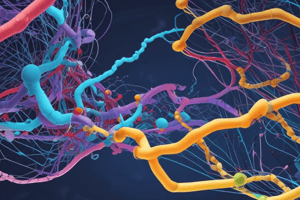Podcast
Questions and Answers
What is the enzyme responsible for the breakdown of glycogen?
What is the enzyme responsible for the breakdown of glycogen?
- Hexokinase
- Glycogen hydrolase
- Glycogen phosphatase
- Glycogen phosphorylase (correct)
What is the result of the radioactive decay of 228 Ra?
What is the result of the radioactive decay of 228 Ra?
- 2 beta particles
- 1 gamma wave
- 1 alpha particle + 1 beta particle (correct)
- 2 alpha particles
How is radioactivity typically detected?
How is radioactivity typically detected?
- Excitation of phosphors in a Scintillation Counter
- Blackening of photographic film in a Dosimeter
- Ionisation of gases in a Scintillation Counter
- Ionisation of gases in a Geiger counter (correct)
What is the half-life of the radionuclide given to the patient?
What is the half-life of the radionuclide given to the patient?
What is the product of the citric acid/Krebs'/TCA cycle?
What is the product of the citric acid/Krebs'/TCA cycle?
What happens in the initial step of the citric acid/Krebs'/TCA cycle?
What happens in the initial step of the citric acid/Krebs'/TCA cycle?
What is the main purpose of oxidative phosphorylation?
What is the main purpose of oxidative phosphorylation?
What would happen if ATP synthase stopped working during oxidative phosphorylation?
What would happen if ATP synthase stopped working during oxidative phosphorylation?
What is the rate law for the elementary reaction of an inhibitor I binding to an enzyme E?
What is the rate law for the elementary reaction of an inhibitor I binding to an enzyme E?
How many substrate molecules are turned over by the enzyme alkaline phosphatase per second?
How many substrate molecules are turned over by the enzyme alkaline phosphatase per second?
What increases glycolysis?
What increases glycolysis?
Which cells benefit from gluconeogenesis?
Which cells benefit from gluconeogenesis?
Which enzyme is responsible for glycogen breakdown?
Which enzyme is responsible for glycogen breakdown?
What is the unit of the maximal initial reaction rate vmax?
What is the unit of the maximal initial reaction rate vmax?
Flashcards are hidden until you start studying
Study Notes
Thermodynamics
- ΔG = -RT ln K
- R = 8.314 J K-1 mol-1
- If ΔG0’ = -220 J mol-1, K can be calculated
Enzyme Kinetics
- Inhibitor I binds to enzyme E according to the reaction scheme
- Rate law for this elementary reaction: d[EI]/dt = k1 [I][E] – k-1 [EI]
Enzyme Alkaline Phosphatase
- vmax = 12.5 μmol L-1 s-1
- Concentration of active enzyme = 0.2 μmol L-1
- Turnover number = 62.5 s-1
Pyruvic Acid Reaction
- In the forward reaction, pyruvic acid donates a proton to water
- In the backward reaction, pyruvate acts as an acid
- Protonated water is not accurately described by “H3O+“
Glycolysis Regulation
- Glycolysis is upregulated by increased levels of AMP
- Glycolysis is downregulated by increased levels of ATP, citrate, and alanine
Gluconeogenesis
- Provides glucose for cells that need a constant supply (brain, red blood cells, anaerobic muscle, and lactating mammary)
- Clears cells of molecular debris
Glycogen Breakdown
- Glycogen phosphorylase is responsible for glycogen breakdown
Radioactive Decay
- 228Ra decays to 228Th, releasing 2 alpha particles
- Radioactivity can be detected via ionisation of gases in a Geiger counter
Radionuclide Decay
- Half-life of radionuclide = 6 hours
- Amount of radionuclide left after 12 hours = 10mCi
- Initial amount of radionuclide = 40 mCi
Citric Acid/Krebs’/TCA Cycle
- Products of the citric acid/Krebs’/TCA cycle include NADH and FADH2
- Initial step: acetyl CoA combines with oxaloacetate to form citrate
Oxidative Phosphorylation
- Main purpose: ATP production through oxidation of NADH and FADH2
- If ATP synthase stopped working, the electron transport chain would show very low activity
Studying That Suits You
Use AI to generate personalized quizzes and flashcards to suit your learning preferences.




